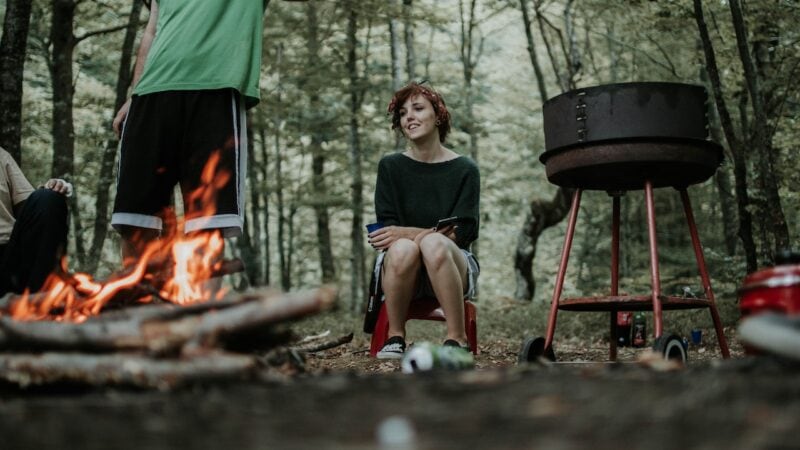Last Updated on January 27, 2025
Picture this: You’ve just set up camp a stone’s throw away from a gorgeous lake. The sun is starting to set, and you’re ready to fire up the grill to cook up some dinner. You have a cold drink in hand, and you just opened up the cooler to grab a ButcherBox New York Strip Steaks that has been sitting in a zesty cilantro marinade since you prepped it back at home. Maybe you’re by yourself, with a partner, or with a gaggle of little children, but as the steak sizzles on the grill and the sun warms your summer tanned skin, you feel content. Because this, right here, is truly what summer is all about. And thanks to these expert grilling tips, you’ll be able to camp and cook with ease, and all of those worries from before brush away with the cool wind rustling through the forest.
Sounds ideal, doesn’t it? If you love to camp during the summer and want to feel just as relaxed as you cook your meal to enjoy around the campfire, then these are the tips that will give you that kind of laid-back confidence that will make grilling at camp an absolute breeze.
1. Pre-plan your meals.
“Firstly, pre-plan your menu and choose straightforward dishes that grill easily, such as hot dogs, chicken, or foil-wrapped veggies,” says Michael Hollander, president at The BBQ Depot. “Preparing marinades before your trip and storing meats and vegetables in ziploc bags not only enhances the flavor but also saves space and cuts down on prep time.”
Some of our ButcherBox favorites include this Kalbi Marinated Flank Steak, these Lemon-Marinated Grilled Chicken Thigh Skewers, and these Simple 3-Ingredient Burgers.
2. Bring the right cooler and cool it down first.
While it may seem convenient to purchase a disposable styrofoam cooler for your camping trip, it may not be worth the up keep, says Nicole Ibarra, RD.
“Not all portable coolers keep food cold for a long time,” she says. “Purchase a cooler that has hard-sided edges rather than the styrofoam ones as they will keep your food cooler for longer.”
A good cooler not only keeps your food cold, but you’ll likely experience less leaking incidents, and you may not have to buy as much ice to keep it cold.
Speaking of keeping it cold, make sure to actually cool down your cooler first before placing anything in it as to avoid food getting warm and ice melting quickly.
“Before you pack it with food, put ice in it to bring the temperature of the cooler down, then empty it and fill it with new bags of ice,” says Wes Wright, founder and CEO of CookOut News. “This will make sure you don’t get to your campsite and find you have warm food with a bunch of water.”
3. Pack the essential utensils.
No campsite cooking experience isn’t complete without the proper tools—and it all starts with having a good grill.
“When it comes to grilling, a lightweight, easy-to-assemble grill is a must,” says Chef Norah Clark, writer at Yummy Taste Food. “Essential tools like a grill brush, long-handled tongs, and a meat thermometer will help ensure delicious, safely cooked meals. And don’t forget to pack reusable eating utensils to minimize your environmental impact.”
Ibarra especially emphasizes bringing a meat thermometer in order to ensure you’re cooking your meat and/or seafood properly as to avoid any chances of food-borne illness.
4. Bring aluminum foil.
If your campsite comes with a grill, make sure to pack aluminum foil for cooking your meat over the fire as to avoid any food contamination.l
“For instance, you could roast small baby potatoes in a foil pouch,” says Ibarra. “A great addition to that would be to use ButcherBox’s Apple Chicken Sausage to pair with it for an easy lunch while camping!”
5. Don’t have a portable grill? Bring a griddle.
If you would rather not chance using a public grill, Wright recommends bringing a griddle with you instead. “While grills are great, with a griddle you can cook all three meals,” he says. “It minimizes the amount of stuff you’re bringing with you.”
Some easy griddle meals include pancakes, Spiced Bacon and Fried Egg Tacos, and Buffalo Chicken Sandwiches.
6. Adhere to the campsite’s safety protocols.
Now that you have everything packed and prepped, it’s time to do your research to make sure you’re following all of the right safety protocols at the campsite. Depending on the state and the particular forest guidelines, it’s crucial to make sure you are following the specific rules the campsite has laid out as to avoid any unnecessary fires or protect yourself—and other campers—from wildlife.
“Be cautious when using campfires or grills,” says Chef Devon Ferguson, senior editor at Carnivore Style. “Always follow proper safety precautions when using campfires or grills. Use long-handled utensils, keep a fire extinguisher nearby, and never leave a fire unattended.
“If you plan to use a gas grill when camping, you’ll want to make sure you abide by fire regulations, many sites, state parks, [and so forth], require campfire permits, so make sure you do your research when planning your trip,” says Hollander. “This goes the same for campfire regulations, for example, a California Campfire Permit states that you must clear all flammable material away from the fire for a minimum of five feet in all directions to prevent the escape of the fire.”
7. Clean your cooking area.
Campsite cleanliness is key for avoiding any thorny situations while you enjoy the great outdoors. This includes putting all of your food away in proper storage to avoid any critters joining your campsite.
“Keep a clean and organized campsite,” says Ferguson. “If you’re camping, make sure to keep your cooking area clean and organized to prevent the spread of bacteria and to avoid attracting animals.”
“Be sure to clean the grill if you brought one before using it to reduce contaminants,” says Ibarra.
8. Pack a portable table
While many campsites will likely provide some kind of picnic table for you to use, it may still be worth bringing a portable table to set up simply to have a place to prepare your food, Hollander suggests. This way your family still has room to hang out and maybe enjoy a pre-dinner snack while you prepare the food, giving everyone enough space to enjoy themselves.
9. Use airtight containers.
“Pack food safely for picnics and outdoor events,” says Ferguson. “Use airtight containers to store food and keep them in a cooler with plenty of ice or ice packs. Pack raw meat separately from other foods to prevent cross-contamination.”
“Store any leftovers properly in smaller containers rather than large ones as larger quantities take a longer time to cool, which could result in food being in the food danger zone,” says Ibarra. The food “danger zone” would be anything above 40 degrees Fahrenheit for cold foods, and 140 degrees for hot foods.
10. Stay hydrated.
Don’t forget to drink water! Even if the weather is cooling off after a hot day, you need to take care of yourself and stay hydrated.
“Going camping or hiking can bring serious health issues, like sunstroke or dehydration,” says Advika Menon, recipe developer and founder of My Spice. “It is essential to drink plenty of fluids throughout the day, especially water to stay hydrated. To reduce the risk of waterborne illness and dehydration, you can carry water purification tablets or a portable water filtration system if possible.”
Kiersten Hickman is a freelance journalist and content strategist, covering a variety of topics in the food, health, and lifestyle categories. Her work has been published by Reader's Digest, Taste of Home, Clean Plates, EatingWell, Eat This, Not That!, Bustle, Stacker, The Everygirl, and more. She also writes Forkful, a weekly essay on Substack debunking diet culture myths, and is in the process of publishing her first novel.



